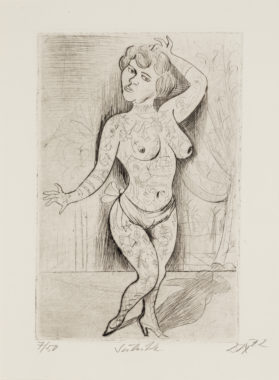Dix, Otto
Sold Artworks
Biography
Otto Dix
1891 Gera – 1969 Singen
Otto Dix entered the Kunstgewerbeschule (now the Academy of Fine Arts) in Dresden in 1910 after completing an apprenticeship as a scene painter under Carl Senff. Thanks to Dresden’s distinguished picture gallery and its thriving avant-garde art scene, the city – once the seat of the rulers of Saxony – played a leading role in the artistic life of Germany in the years before World War I. The influence of Dresden’s rich artistic climate is clearly felt in Dix’s early work. Very varied in terms of style and subject matter, his work ranged from an intense preoccupation with the work of the Old Masters to a simultaneous engagement with contemporary artistic trends. Albrecht Dürer and Lucas Cranach, Max Klinger and Vincent van Gogh, Edvard Munch and Ludwig Meidner were just some of his major sources of inspiration.
The outbreak of World War I put an end to Dix’s training at the Kunstgewerbeschule. After receiving a basic military training he volunteered enthusiastically for the German Army. He spent the following three years as a NCO in active service, almost uninterruptedly at a number of fronts. Unlike many of his contemporaries he did not suffer psychological breakdown as a result of combat and direct confrontation with the horror, brutality and unspeakable depravities of industrialised mass murder. Instead, war, which he saw as a natural process of purification and renewal, released in him a frenzy of creative activity. He was profoundly affected by his experiences in the trenches and dugouts and recorded his observations in hundreds of drawings and watercolours. The works he produced on the battlefield range from images of cynical self-reaffirmation to abstract apocalyptic visions. They span the entire spectrum of modernist artistic expression. Even after his discharge from the Army his experience of war and its aftermath remained a dominant theme in his oeuvre.
In 1919, Dix returned to Dresden and resumed his studies at the Hochschule für Bildende Kunst. As a master class student he was given a studio of his own. In his working methods he was guided by the principles of adaptation and transformation and experimented with the use of Expressionist, Cubist and Futurist elements. His versatility attracted the attention of older and younger generations of artists. His friend Conrad Felixmüller taught him etching and lithography techniques. He rapidly developed outstanding skills as a printmaker. Prints were an efficient method for widely disseminating the themes that preoccupied him and also secured him a regular income. At the First International Dada Fair in Berlin in 1920 Dix met George Grosz and John Heartfield. During the Weimar Republic they became the most radical voices of social criticism in Germany. But Dix soon broke with modernist trends and adopted a style of realism reminiscent of German Renaissance painting. Until the Nazi takeover and establishment of the Third Reich in 1933, he used his own brand of realism as a tool to paint an unsparing, politically explosive picture of contemporary social evils and injustices.
Before long, Dix was branded as a troublemaker. His constant embrace of taboo subjects and his acerbic portrayal of them led to regular clashes with the authorities. Wherever he happened to be living during the Weimar Republic, whether in Dresden, Düsseldorf or Berlin, his hyperrealistic, detail-laden images of destitute prostitutes, war cripples and workers caused public outrage. Despite their psychological subtlety, his portraits projected a less than flattering view of humanity as a whole, which hardly mitigated the situation. But he also took rare pleasure in the grotesque, sometimes even showing a tendency towards caricature. This took at least some of the edge off the polemical aspect of his work. The use of satirical accents thus allowed it to be both a mirror and a commentary on the circumstances portrayed. This convinced influential gallerists like Johanna Ey in Düsseldorf and Karl Nierendorf in Berlin to promote his work among collectors and museums and led to its recognition as one of the outstanding achievements of New Objectivity.
Dix’s nomination as a professor at the Dresden Academy of Art in 1926 proved that there were strong advocates of his work in his former adopted town of Dresden as well as opponents. But the year 1933 marked a turning point in his life and artistic career. A few months after the Nazis seized power he was dismissed from his professorial post at the Academy and banned from exhibiting his work. His paintings were labelled as ‘degenerate’ and removed from German museums. He had no illusions about his personal situation as an artist and left Dresden in the summer of 1933. He eventually found refuge near Lake Constance, where he withdrew into what can be termed as an ‘inner emigration’ until the Third Reich fell in 1945. He began to focus almost exclusively on politically inoffensive landscapes as well as religious and mythological subjects. In his post-war work he abandoned realism for a looser, more spontaneous alla prima approach. This new-found creative impulse brought him numerous awards and much respect.
PDF Download